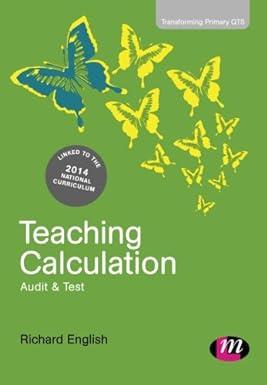Question
Entries into T accounts and Trial Balance Connie Young, an architect, opened an office on October 1, 2019. During the month, she completed the following
-
Entries into T accounts and Trial Balance
Connie Young, an architect, opened an office on October 1, 2019. During the month, she completed the following transactions connected with her professional practice:
- Transferred cash from a personal bank account to an account to be used for the business, $36,000.
- Paid October rent for office and workroom, $2,400.
- Purchased used automobile for $32,800, paying $7,800 cash and giving a note payable for the remainder.
- Purchased office and computer equipment on account, $9,000.
- Paid cash for supplies, $2,150.
- Paid cash for annual insurance policies, $4,000.
- Received cash from client for plans delivered, $12,200.
- Paid cash for miscellaneous expenses, $815.
- Paid cash to creditors on account, $4,500.
- Paid $5,000 on note payable.
- Received invoice for blueprint service, due in November, $2,890.
- Recorded fees earned on plans delivered, payment to be received in November, $18,300.
- Paid salary of assistants, $6,450.
- Paid gas, oil, and repairs on automobile for October, $1,020.
Required:
1. Record the above transactions (in chronological order) directly in the following T accounts, without journalizing. Cash; Accounts Receivable; Supplies; Prepaid Insurance; Automobiles; Equipment; Accounts Payable; Notes Payable; Connie Young, Capital; Professional Fees; Salary Expense; Blueprint Expense; Rent Expense; Automobile Expense; Miscellaneous Expense. To the left of each amount entered in the accounts, select the appropriate letter to identify the transaction.
2. Determine account balances of the T accounts. Accounts containing a single entry only (such as Prepaid Insurance) do not need a balance.
Cash c. c. Bal. Accounts Receivable Supplies Prepaid Insurance Automobiles Equipment Accounts Payable Bal. Notes Payable Bal. Connie Young, Capital Professional Fees Bal. Salary Expense Blueprint Expense Rent Expense Automobile Expense Miscellaneous Expense Feedback
1. and 2. First, identify what account is used and then what type of account is used. Every account is either an asset, liability, capital, withdrawal, revenue, or expense account. Every transaction involves at least two accounts. Then determine whether the account increases or decreases. Each increase or decrease is recorded as a debit or credit in the T-accounts, following the rules of debit and credit. Net debits against credits to determine the balance and double-check to see if it is a normal balance for that account classification.
3. Prepare an unadjusted trial balance for Connie Young, Architect, as of October 31, 2019. If an amount box does not require an entry, leave it blank.
Connie Young, Architect Unadjusted Trial Balance October 31, 2019 Debit Balances Credit Balances Feedback
3. The trial balance lists the ending balance of each account in a corresponding Debit or Credit column. The trial balance column totals should be equal.
4. Determine the net income or net loss for October. $
Feedback
4. Recall that Revenue - Expenses = Net Income (Loss).
Feedback
Incorrect
Step by Step Solution
There are 3 Steps involved in it
Step: 1

Get Instant Access to Expert-Tailored Solutions
See step-by-step solutions with expert insights and AI powered tools for academic success
Step: 2

Step: 3

Ace Your Homework with AI
Get the answers you need in no time with our AI-driven, step-by-step assistance
Get Started


